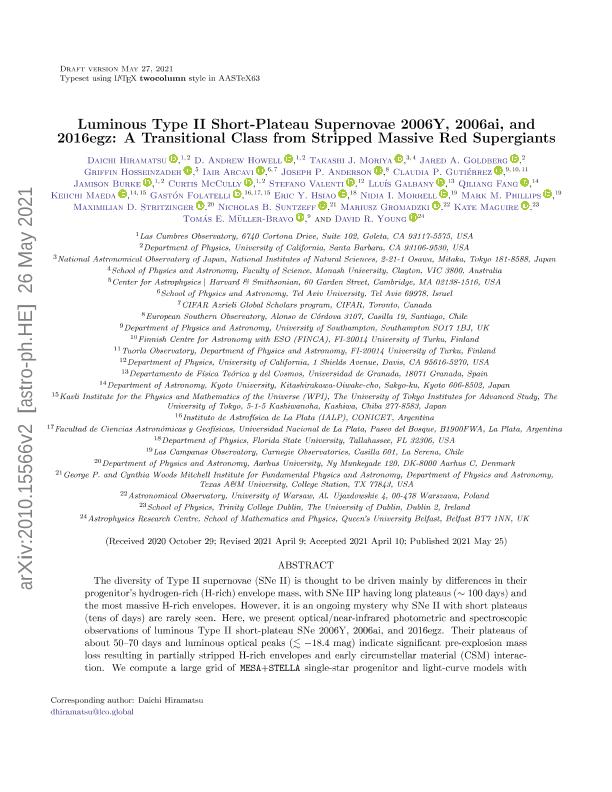Artículo
Luminous Type II Short-Plateau Supernovae 2006Y, 2006ai, and 2016egz: A Transitional Class from Stripped Massive Red Supergiants
Hiramatsu, Daichi; Howell, D. Andrew; Moriya, Takashi J.; Goldberg, Jared A.; Hosseinzadeh, Griffin; Arcavi, Iair; Anderson, Joseph; Gutiérrez, Claudia P.; Burke, Jamison; McCully, Curtis; Valenti, Stefano; Galbany, Lluís; Fang, Qiliang; Maeda, Keiichi; Folatelli, Gaston ; Hsiao, Eric Y.; Morrell, Nidia Irene
; Hsiao, Eric Y.; Morrell, Nidia Irene ; Phillips, Mark M.; Stritzinger, Maximilian D.; Suntzeff, Nicholas B.; Gromadzki, Mariusz; Maguire, Kate; Müller Bravo, Tomás E.; Young, David R.
; Phillips, Mark M.; Stritzinger, Maximilian D.; Suntzeff, Nicholas B.; Gromadzki, Mariusz; Maguire, Kate; Müller Bravo, Tomás E.; Young, David R.
 ; Hsiao, Eric Y.; Morrell, Nidia Irene
; Hsiao, Eric Y.; Morrell, Nidia Irene ; Phillips, Mark M.; Stritzinger, Maximilian D.; Suntzeff, Nicholas B.; Gromadzki, Mariusz; Maguire, Kate; Müller Bravo, Tomás E.; Young, David R.
; Phillips, Mark M.; Stritzinger, Maximilian D.; Suntzeff, Nicholas B.; Gromadzki, Mariusz; Maguire, Kate; Müller Bravo, Tomás E.; Young, David R.
Fecha de publicación:
05/2021
Editorial:
IOP Publishing
Revista:
Astrophysical Journal
ISSN:
0004-637X
Idioma:
Inglés
Tipo de recurso:
Artículo publicado
Clasificación temática:
Resumen
The diversity of Type II supernovae (SNe II) is thought to be driven mainly by differences in their progenitor´s hydrogen-rich (H-rich) envelope mass, with SNe IIP having long plateaus (∼100 days) and the most massive H-rich envelopes. However, it is an ongoing mystery why SNe II with short plateaus (tens of days) are rarely seen. Here, we present optical/near-infrared photometric and spectroscopic observations of luminous Type II short-plateau SNe 2006Y, 2006ai, and 2016egz. Their plateaus of about 50-70 days and luminous optical peaks (≲-18.4 mag) indicate significant pre-explosion mass loss resulting in partially stripped H-rich envelopes and early circumstellar material (CSM) interaction. We compute a large grid of MESA+STELLA single-star progenitor and light-curve models with various progenitor zero-age main-sequence (ZAMS) masses, mass-loss efficiencies, explosion energies, 56Ni masses, and CSM densities. Our model grid shows a continuous population of SNe IIP-IIL-IIb-like light-curve morphology in descending order of H-rich envelope mass. With large 56Ni masses (⪆0.05 M o˙), short-plateau SNe II lie in a confined parameter space as a transitional class between SNe IIL and IIb. For SNe 2006Y, 2006ai, and 2016egz, our findings suggest high-mass red supergiant (RSG) progenitors (M ZAMS ≃ 18-22 M o˙) with small H-rich envelope masses () that have experienced enhanced mass loss () for the last few decades before the explosion. If high-mass RSGs result in rare short-plateau SNe II, then these events might ease some of the apparent underrepresentation of higher-luminosity RSGs in observed SN II progenitor samples.
Palabras clave:
SUPERNOVAE
Archivos asociados
Licencia
Identificadores
Colecciones
Articulos(IALP)
Articulos de INST.DE ASTROFISICA LA PLATA
Articulos de INST.DE ASTROFISICA LA PLATA
Citación
Hiramatsu, Daichi; Howell, D. Andrew; Moriya, Takashi J.; Goldberg, Jared A.; Hosseinzadeh, Griffin; et al.; Luminous Type II Short-Plateau Supernovae 2006Y, 2006ai, and 2016egz: A Transitional Class from Stripped Massive Red Supergiants; IOP Publishing; Astrophysical Journal; 913; 1; 5-2021; 1-27
Compartir
Altmétricas



